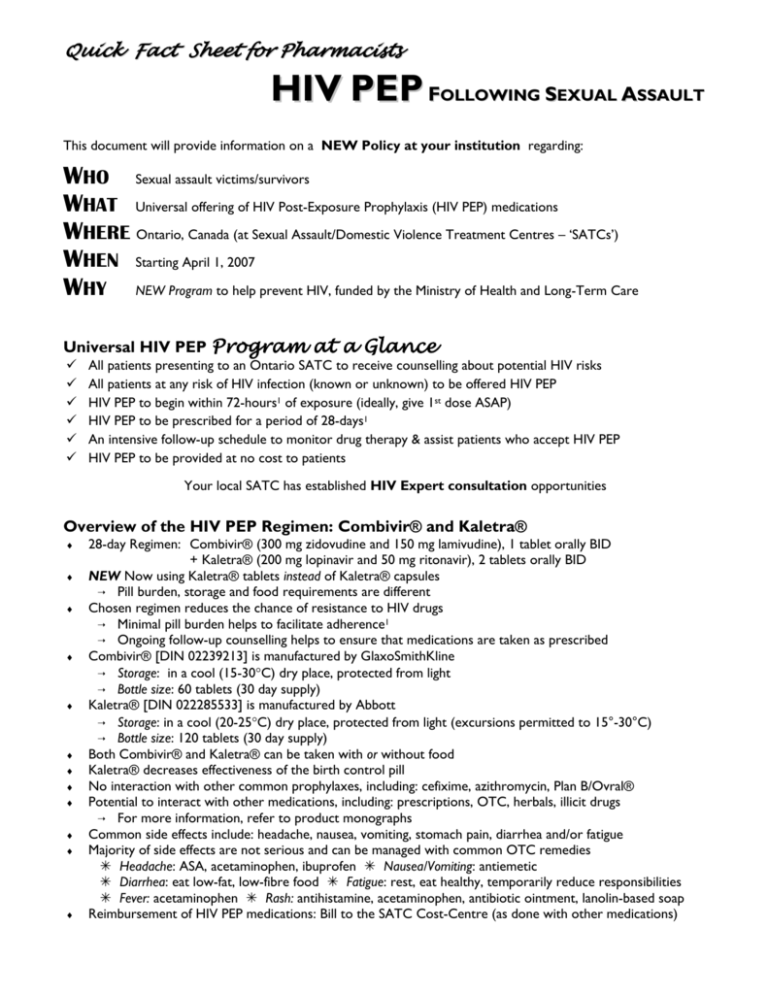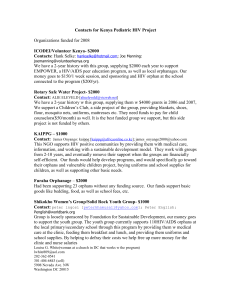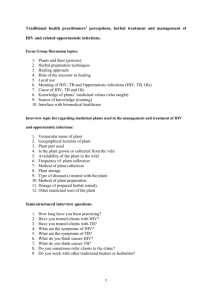
Quick Fact Sheet for Pharmacists
HIV PEP FOLLOWING SEXUAL ASSAULT
This document will provide information on a NEW Policy at your institution regarding:
WHO Sexual assault victims/survivors
WHAT Universal offering of HIV Post-Exposure Prophylaxis (HIV PEP) medications
WHERE Ontario, Canada (at Sexual Assault/Domestic Violence Treatment Centres – ‘SATCs’)
WHEN Starting April 1, 2007
WHY NEW Program to help prevent HIV, funded by the Ministry of Health and Long-Term Care
Universal HIV PEP Program at a Glance
All patients presenting to an Ontario SATC to receive counselling about potential HIV risks
All patients at any risk of HIV infection (known or unknown) to be offered HIV PEP
HIV PEP to begin within 72-hours1 of exposure (ideally, give 1st dose ASAP)
HIV PEP to be prescribed for a period of 28-days1
An intensive follow-up schedule to monitor drug therapy & assist patients who accept HIV PEP
HIV PEP to be provided at no cost to patients
Your local SATC has established HIV Expert consultation opportunities
Overview of the HIV PEP Regimen: Combivir® and Kaletra®
28-day Regimen: Combivir® (300 mg zidovudine and 150 mg lamivudine), 1 tablet orally BID
+ Kaletra® (200 mg lopinavir and 50 mg ritonavir), 2 tablets orally BID
NEW Now using Kaletra® tablets instead of Kaletra® capsules
Pill burden, storage and food requirements are different
Chosen regimen reduces the chance of resistance to HIV drugs
Minimal pill burden helps to facilitate adherence1
Ongoing follow-up counselling helps to ensure that medications are taken as prescribed
Combivir® [DIN 02239213] is manufactured by GlaxoSmithKline
Storage: in a cool (15-30C) dry place, protected from light
Bottle size: 60 tablets (30 day supply)
Kaletra® [DIN 022285533] is manufactured by Abbott
Storage: in a cool (20-25C) dry place, protected from light (excursions permitted to 15°-30°C)
Bottle size: 120 tablets (30 day supply)
Both Combivir® and Kaletra® can be taken with or without food
Kaletra® decreases effectiveness of the birth control pill
No interaction with other common prophylaxes, including: cefixime, azithromycin, Plan B/Ovral®
Potential to interact with other medications, including: prescriptions, OTC, herbals, illicit drugs
For more information, refer to product monographs
Common side effects include: headache, nausea, vomiting, stomach pain, diarrhea and/or fatigue
Majority of side effects are not serious and can be managed with common OTC remedies
Headache: ASA, acetaminophen, ibuprofen Nausea/Vomiting: antiemetic
Diarrhea: eat low-fat, low-fibre food Fatigue: rest, eat healthy, temporarily reduce responsibilities
Fever: acetaminophen Rash: antihistamine, acetaminophen, antibiotic ointment, lanolin-based soap
Reimbursement of HIV PEP medications: Bill to the SATC Cost-Centre (as done with other medications)
Program Rationale: Why Offer HIV PEP?
HIV PEP is recommended to prevent transmission of HIV following occupational and non-occupational
exposures such as unprotected sexual activities and injection drug use1
Ontario Ministry of Health and Long-Term Care endorses this program & fully funds HIV PEP medications
through your local Sexual Assault/Domestic Violence Treatment Centre (SATC)
Heterosexual transmission is increasing (⅓ of HIV-positive test reports in Canada, 2005)2
Women are twice as likely as men to contract HIV during (vaginal) intercourse3
39% of Canadian women experience at least one incident of sexual assault since the age of 164
HIV transmission following sexual assault may be greater (than consensual sex) due to presence of blood,
sexually transmitted infections (STI) in the assailant or victim and/or exposure to multiple assailants
Evidence to Support Non-Occupational HIV PEP
HIV PEP is widely used in occupational exposure & mother-to-child transmission settings1,5,6
Difficult to study in non-occupational setting due to ethical concerns re: study design and sample sizes
Efficacy studied in occupational exposure – taking HIV PEP reduced odds of HIV infection by 81%7
Animal studies – early initiation of HIV PEP is more effective in preventing HIV infection1,6,8,9
Efficacy studied in mother-to-child transmission – a combination of pre-exposure and post-exposure
prophylaxis for the neonate reduces HIV transmission by up to ⅔ 1,6,1011,12
Guidelines for the provision of HIV PEP following sexual assault have been developed and implemented in
multiple North American and European jurisdictions6,13,14,15,16,17
High HIV PEP uptake & completion rates captured in an evaluation of Ontario’s universal HIV PEP program
(2003-2005) indicate a clear demand for this program
Assessing HIV Risk
When the risk of transmission is unknown, it cannot be assumed as zero
Considerations in estimating the probability that an assailant is HIV-positive: local HIV seroprevalence;
potential to belong to high-risk group (e.g., IVDU, MSM, ex-prisoner, from country with high rates of HIV)
‘Universal’ Offering = HIV PEP is accessible to all patients at any risk of HIV
Weighing Risks and Benefits: HIV and HIV PEP
Potential benefits of HIV PEP are measured by balancing anticipated efficacy against individual health risks
Risk of HIV = Risk of HIV-positive assailant + Type of exposure (anal, vaginal or oral – risk increases with
physical trauma, presence of blood, STIs, multiple assailants, multiple receptive sites)
Risks associated with HIV PEP – Potential of adverse effects (rare in literature); Potential development of
drug resistance, especially if adherence is poor (rare due to combination ART therapy)1
HIV PEP does not prevent all infections in occupational and perinatal settings. Similarly, it is not expected to
have complete efficacy after non-occupational exposures, including sexual assault1
Risks and benefits should be determined in conjunction with each patient on a case-by-case basis
1
CDC. 2005. Antiretroviral Postexposure Prophylaxis After Sexual, Injection-Drug Use, or Other Non-occupational Exposure to HIV in the United States: Recommendations from the U.S. Department of
Health and Human Services. MMWR. 54(RR-2): 1-20.
2
Public Health Agency of Canada. 2006. HIV and AIDS in Canada: Surveillance Report to December 31, 2005. Surveillance and Risk Assessment Division, Centre for Infectious Disease Prevention and Control
3
European Study Group. 1992. Comparison of female to male and male to female transmission of HIV in 563 stable couples. BMJ. 304: 809-13.
4
Federal/Provincial/Territorial Ministers Responsible for the Status of Women. 2002. Assessing Violence Against Women: A Statistical Profile.
5
Grulich AE. 2003. Epidemiologically targeted post-exposure prophylaxis against HIV: An under-utilized prevention technology. HIV Medicine. 4: 193-4.
6
European Project on Non-Occupational Post Exposure Prophylaxis. 2002. Management of non-occupational post exposure prophylaxis to HIV: Sexual, injection drug user or other exposures.
7
Cardo DM, Culver DH, Ciesielski CA, Srivastava PU, Marcus R, Abiteboul D, Heptonstall J, Ippolito G, Lot F, McKibben PS, Bell DM. 1997. A case-control study of HIV seroconversion in health care workers
after percutaneous exposure. New England Journal of Medicine. 337(21): 1485-90.
8
Tsai CC, Emau P, Follis KE, Beck TW, Benveniste RE, Bischofeberger N, Lifson JD, Morton WR. 1998. Effectiveness of postinoculation (R)-9-(2-phosphonylmethoxypropyl) adenine treatment for prevention of
persistent simian immunodeficiency virus SIVmne infection depends critically on timing of initiation and duration of treatment. Journal of Virology. 72: 4265–73.
9
Otten RA, Smith DK, Adams DR, Pullium JK, Jackson E, Kim CN, Jaffe H, Janssen R, Butera S, Folks TM. 2000. Efficacy of postexposure prophylaxis after intravaginal exposure of pig-tailed macaques to a
human-derived retrovirus (human immunodeficiency virus type 2). Journal of Virology. 74: 9771–5.
10
Connor EM, Sperling RS, Gelber R. 1994. Reduction of maternal-infant transmission of human immunodeficiency virus type 1 with zidovudine treatment. Pediatric AIDS Clinical Trials Group Protocol 076
Study Group. New England Journal of Medicine. 331(18):1173-1180.
11
Wade NA, Birkhead GS, Warren BL, Charbonneau TT. 1998. Abbreviated regimens of zidovudine prophylaxis and perinatal transmission of the human immunodeficiency virus. NEJM. 339: 1409–14.
12
Sperling RS, Shapiro DE, Coombs RW, 1996. Maternal viral load, zidovudine treatment, and the risk of transmission of human immunodeficiency virus type 1 from mother to infant. NEJM 335: 1621–9.
13
Wiebe ER, Comay SE, McGregor M, Ducceschi S. 2000. Offering HIV prophylaxis to people who have been sexually assaulted: 16 months' experience in a sexual assault service. Canadian Medical Association
Journal. 162(5): 641-5.
14
Non-occupational HIV PEP Task Force, Brown University AIDS Program, and the Rhode Island Department of Health. 2002. Non-occupational human immunodeficiency virus post-exposure prophylaxis
guidelines for Rhode Island healthcare practitioners.
15
New York State Department of Health AIDS Institute. 2004. HIV Prophylaxis Following Non-Occupational Exposure Including Sexual Assault.
16
Myles JE, Bamberger J. 2001. Offering HIV Prophylaxis Following Sexual Assault: Recommendations for the State of California. Prepared for the Housing and Urban Health of the San Francisco Department of
Public Health and The California HIV PEP after Sexual Assault Task Force in conjunction with The California State Office of AIDS.
17
Massachusetts Department of Public Health. 2005. HIV Prophylaxis Following Non-Occupational Exposures Recommended Protocol Components.
For more information, visit: www.satcontario.com/HIVPEP/





